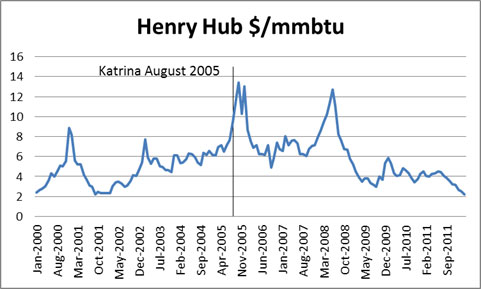Coal to gas switching or should we say displacement volumes
Coal to gas switching is much talked about this year. Many people like the switching word; but there is a dynamic that is occurring and also the term switching in the power industry, typically refers to units who have dual fuel. The better word is probably displacement – semantics.
There is two parts to the coal to gas displacement – structural and economic. The structural part is quite easy to discuss. The US market typically has required 50%+ of its generation from coal. Assuming no decline in load growth if coal units retire other units would need to fill in that void of generation. This part is the structural part of the displacement. As many have shown there are significant EPA rules which lead to the retirement of coal units. Now with the addition of the economic competition to coal from low gas price that may exacerbate the volume of retirements. Obviously the selection of which coal unit retirement will likely be based on how much that coal unit is used and how economically competitive it is. Those units who still run significantly will either already have the necessary control equipment to meet the EPA rules or it will likely be economically to install those controls. Therefore for a proxy one could look at the coal generation by plant from last year and stack up the capacity and generation. Also if one is savvy, one can also get a proxy cost of generation from each plant.
Now that you have generation stacked with capacity and cost you can do a calculation to calculate the approximate amount of gas generation if X capacity of coal was going to retire. I would not use a Combine Cycle heat rate (7) since some of that generation may be actually at peak times since some of the older coal plants are likely running at those time. In this example I used an 8 heat rate. Summing the data to produce 20GW of capacity retirements, produces 1.3 bcf/d of additional gas demand. Going to 40 GW of capacity retirements we are looking at 2.7 bcf/d. All this is the structural piece. Given the push for green energy the numbers will be lower some of the above number. The surprising perspective for many is that the gas potential in the power sector can be as dependent on the renewable outlook as the coal outlook.
In terms of the economic portion, this is the very dynamic portion. I have done much work in this arena and have given multiple presentations. This is very dependent on your price outlooks for both gas and coal, particularly on sustainable basis. In addition, time plays a crucial part in the analysis. One has to ask displacement for this week, next month, or next year. Each of those time periods various inputs into a dispatch model must be modified. Also the basis of displacement is being mixed in with natural load growth which in general is being filled in by gas or renewables. Therefore some analysis will say 10 bcf/d of switching will be seen in the next few years, but that includes a load growth which would have occurred regardless. If you are interested in getting some ball park numbers give me a call 614-356-0484 or email me [email protected] and be prepared to tell me the timeline, gas prices, and coal prices.
We positively and evocatively challenge the current thinking involving any aspect of energy use. We look for projects that offer meaningful, transformative, with impactful outcome to the marketplace or society.
Independent analysis and opinions without a bias right is what we offer to our clients. Please consider and contact All Energy Consulting for your consulting needs.
Your Energy Consultant,
To be right now and be praised or to be right in the long run and be hated
I did want to write about the energy space since there is much to discuss, but this issue has been nagging me. Recently I came across an article on Zerohedge on a presentation focused on the “Deficits don’t matter”. Then I keep on recalling Henry Blodgets article on Business Insider saying Keynes was right.
Both articles highlight my title: “To be right now and be praised or to be right in the long run and be hated.” This reminds me of the Greek tale of Cassandra. I think most will likely go with the first. There is no doubt a stimulus now will always feel better now. Deficits don’t matter can be rephrased – “If you can live on credit why not?” I don’t think the deficit hawks would say the economy would blow up in the next few years if we did significant monetary printing now. The next few years will no doubt feel and be better with the printing press on. It’s a question of the extent and when and who should pay the bill. I can agree with Paul Krugman that an avoidance of a depression may be worthy of printing in order to have a slower economy later. However, I am agreeing as a selfish individual. Clearly the statement is concluding – there is growth to be taken from the future to get by now. By following this recipe does the culprit of the wasteful spending ever get taught a lesson or are we creating another moral hazard. Poor capital allocation is okay because it will be supported by more spending and will be supported by future potential growth.
Time for an analogy: Since your child will be a doctor in the future, one can just rack up loans and live the good life because in the future your child will help you with your loans. At some level the child does owe some of it to you, but you are clearly requiring him/her to live less of lifestyle as they could have. Is this the path we are on?
So I throw caution to those praising our stimulus promoters and marching the victory parade. The victory parade can be made for a few, but it won’t likely be a parade 20 years from now. Optimistically, I believe the future generation will and can carry the weight, I just hope we don’t pile it on too high to the point Atlas will shrug.
We positively and evocatively challenge the current thinking involving any aspect of energy use. We look for projects that offer meaningful, transformative, with impactful outcome to the marketplace or society.
Independent analysis and opinions without a bias right is what we offer to our clients. Please consider and contact All Energy Consulting for your consulting needs.
Your Energy Consultant,
614-356-0484
Being Green is Hard
Once again I sit in the airport writing this blog. Your energy analyst has been very busy – which is a good thing. As I noted in my previous blog, I have been doing the twitter thing. The people I have chosen to follow are not just the people that believe what I believe in. One person I follow, David Roberts, is from the Grist. The Grist is an interesting publication focused on the environment. They claim not to be too much of a tree-hugger. Mr. Roberts is clearly a self-professed liberal – I deduce this from the continuous negative connotations for the GOP, along with little to none negativity with the democrats. Once again I don’t mind at all to view and read his point of views. Clearly he is right on many of the issues that he points out with regards to the GOP.
One of his latest blog he asked the twitter world whether he should buy a Prius V or VW TDI. I really didn’t think he meant to ask me, but I do follow him. Therefore I suggested to him he should probably think about buying a used car or better yet drive his existing car to death. This is largely due to the fact that most of a car CO2 emission is from the manufacturing and marketing of the vehicle versus the actual fuel consumption for the life of the vehicle. Those who feel they are being green by buying a new ultra-efficient vehicle, while they have a mechanically functioning vehicle, have not seriously examined the complete picture. I even note an article from the Guardian who also supports that claim.
I have yet received a reply for my kindness of taking the time and answering his request from his twitter follower. However, I write this only to point out the reality that it really is hard to be green. Being green takes sacrifice in your lifestyle, which many do not want to do.
We positively and evocatively challenge the current thinking involving any aspect of energy use. We look for projects that offer meaningful, transformative, with impactful outcome to the marketplace or society.
Independent analysis and opinions without a bias right is what we offer to our clients. Please consider and contact All Energy Consulting for your consulting needs.
Your Energy Consultant,
Capitalism to Creditism to Green Economy?
Mike Shedlock posted an interesting blog discussing Richard Duncan perception on the end of Capitalism, and the conversion to “creditism”. Mr. Duncan also noted the reversal of the situation is near to impossible, therefore he concludes government should go ahead and borrow and spend money to make the world a better place. Unfortunately, he chooses the recent Green Economy as his choice of government spending pointing out a government solar build out in Nevada would be an ideal project.
Mr. Shedlock argues the issue that government projects never seem to work out as planned. Generally speaking I agree with most of Mr. Shedlock arguments to Mr. Duncan plan. However, I think they both miss the point I have been preaching “Energy is a means to an end.” If the government wants to take the Mr. Duncan suggestions, the most effective way to advance society is to focus on the ends not the means. One can have all the energy in the world, but if you don’t plan on using it in a productive manner that advantage becomes irrelevant. We need to stop with this Green economy concept. We need to think about how we better utilize and use energy in order to produce and manufacture products and services that society can use to better us all. I believe if we do focus on this, naturally, we will produce “greener” energy. However right now we are just fooling ourselves that by making a Green Economy we will be better in the long run. I never have seen a case where if I challenge my means/path it produces a better end.
I am pro-renewables in many ways. The subsidization path, particularly without innovation beyond the engineering sense, will not lead to a better outcome in the long run. I discuss this some more in previous blog.
We positively and evocatively challenge the current thinking involving any aspect of energy use. We look for projects that offer meaningful, transformative, with impactful outcome to the marketplace or society.
Independent analysis and opinions without a bias right is what we offer to our clients. Please consider and contact All Energy Consulting for your consulting needs.
Your Energy Consultant,
614-356-0484
The Demise of Coal Overstated
As I noted in my previous blog, I spoke at a power symposium last week. Many of the speakers had concluded coal is dead. The rhetoric is the same on the internet and major publications. People have even spoken to the point to say coal is more expensive than gas. This is sadly far from the truth.
Weather played a key role in the current price predicament for natural gas. One year should never be extrapolated when weather played such a crucial role – case in point look at the price action in natural gas prices after Hurricane Katrina.
It is a true statement for those trading – “Markets can remain irrational longer than you can remain solvent.” You can see it almost took 6 months for Katrina’s price impact to fade. One could look at the current situation as the inverse situation – instead of a hurricane reducing supply you have a mild winter reducing demand. It takes time for fundamentals to rebalance the market. The price rebalancing can take even longer as noted in the irrational markets discussion. The irrational price levels of today’s market are natural gas prices below coal market contracts. Ultimately those contracts will roll off and the negotiations for the coal contracts will come down or no longer cease to exist. Conservatively, I would estimate we are in the fourth month of un-fundamentally low prices. I can foresee continued pressure downward on natural gas prices, but not past this year as long as we revert to normal weather.
For those saying it is over for coal, they are forgetting their game theory rules. For every action there will be a reaction from those most impacted. Coal consumption could potentially drop over 20% this year relative to last year’s consumption. Inversely gas consumption in the power sector could see a rise of over 60% from last year’s consumption. These two actions do not come without consequences/reactions. As I indicated above, I expect coal prices to come down. Inversely, I expect gas prices to rise. It is not if, it is just a matter of when. This combination will allow coal to once again prosper. Coal consumption will not regain its majority spot for generation (>50%) given the environmental policies and the corresponding retirements, but I expect coal will continue to be the top 3 source type of generation for the US for many years to come.
Please do consider All Energy Consulting to help you understand where the markets will be and how best to align your organization to capture the change.
We positively and evocatively challenge the current thinking involving any aspect of energy use. We look for projects that offer meaningful, transformative, with impactful outcome to the marketplace or society.
Independent analysis and opinions without a bias right is what we offer to our clients. Please consider and contact All Energy Consulting for your consulting needs.
Your Energy Consultant,
614-356-0484
Volatility in the Power Markets Inevitable
Last week, I spoke at the Flexible Power Symposium. I will note for my readers that I was rated as one of the highest speakers for the symposium. Many told me first hand, I was the best speaker. Speaking on a stage is natural for me, given my youth background as an aspiring actor. I had the privilege of attending the High School for the Performing Visual Arts in Houston. However, my analytical mind got the best of my aspirations as I looked at my probabilities of success and my required income.
Nonetheless, my talk consisted of laying out the issues confronting the energy markets. I titled my presentation “Unintended Consequences from Good Intentions in the Electric Markets”. As typical of my style of presenting, the slides were much less important than what I had to say. I focused on the three areas on which, as a society ,we should strive for in the electric markets – Renewables, Environmental Policy, and Better Market Design. I made it clear to the audience, I am pro-renewable and environment, but I am also cognizant of the trade-offs. This is probably where I may lose some of you. The externality of the fossil generation is real. The plant is emitting potentially harmful chemicals. However, as in life, there are trade-offs and the corresponding externalities. Extreme environmentalists like to ignore this other side of the equation. Having low cost generation, though more environmentally harmful, offer externality factors of greater expanded use of power which can generate jobs, save lives, and include making society feel better (e.g. comfortable temperature). As I noted in my discussion of the MATS rule by the EPA, our choices to spend for environmental improvements need to be balanced with alternative for use for that capital (financial and human). In addition we really need to understand what our goals are when we plan to spend resources.
Many speakers ahead of me already discussed the variability of renewables in terms of generation. The interesting points in the variability discussions, the wind is hourly whereas the variability of solar is in minutes. In addition, wind is quite spatially consistent. Wind blows simultaneously at the same levels for large regions. Whereas solar can have some balancing effect if there is large regions of solar. I also pointed out the choice of renewables given the higher cost, does take away from the economy as energy is only a means to an end. Many models only consider the wholesale power price, but given renewables are largely done through power purchase agreements (PPA) which are rolled into rates wholesale power prices are less relevant when it pertains to consumer pricing.
Environmental policy already in effect will retire coal units. Many of the coal units support many of the ancillary services: of the electric market – load, following ability, voltage and reactive load support, unit frequency response and system restoration or black start. In a Catch-22, the price signals of each of these services are essentially non-existent due to the large sunk cost in these facilities. There is bound to be a bumpy path as the units get removed from the system and the price signals for investments in these services catch up.
Market design, to regulate or to de-regulate, that is the question. I talked about the pros and cons. Ultimately many markets are already on the path of de-regulation. These markets are bound for market volatility as returns required for investments are higher in de-regulated environment. In addition, high return industries naturally move in business cycles (over to under investments).
In conclusion, given the three areas of renewables: environmental policy, market design, and the future electric markets are bound to see volatile pricing. There will be winners and losers. The losers may be the rate payers as they could see higher prices with less reliability. The winners will be those who have the flexibility and the forethought to skate to where the market will be not where it is now.
Please do consider All Energy Consulting to help you understand where the markets will be and how best to align your organization to capture the change.
We positively and evocatively challenge the current thinking involving any aspect of energy use. We look for projects that offer meaningful, transformative, with impactful outcome to the marketplace or society.
Independent analysis and opinions without a bias right is what we offer to our clients. Please consider and contact All Energy Consulting for your consulting needs.
Your Energy Consultant,







